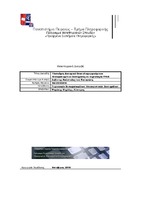Υλοποίηση δυναμικά επαναδιαμορφούμενου ενσωματωμένου συστήματος σε τεχνολογία FPGA

Master Thesis
Author
Λεβέντης, Απόστολος Π.
Date
2011-09-28View/
Subject
Integrated circuits -- Very large scale integration ; Field programmable gate arrays -- Design and construction ; System design -- Data processing ; Σχεδιασμός συστημάτωνAbstract
At their third decade, not only are FPGAs a technologically mature platform being used for rapid system prototyping but they are also a viable replacement option for ASICs in commercial product implementations. A significant factor for the adoption of FPGAs was their improvement in the areas of ASIC technology superiority, i.e. the capacity in logic gates, the speed and power consumption. While still behind ASICs, FPGAs‟ use uncovered some of their inherent advantages such as their almost zero Non-Recurring Engineering cost, their fast implementation cycle and their capability for reprogramming. This last characteristic is very important as it allows for changes and modifications in a finalized circuit, something impossible with ASIC technology implementation. Some FPGAs go further, offering the possibility to modify the device functionality during its operation, thus allowing a part of the FPGA device to change its functionality without destructing the rest of it. This functionality is called Dynamic Reconfiguration and opens a new application area to FPGAs allowing, for example, the creation of systems that dynamically adapt to the conditions of their operating environment or have self-healing capabilities. In this thesis, the Dynamic Reconfiguration is studied and the process of implementing it in an FPGA-based embedded system is presented. The objective is to identify the advantages offered by a dynamic system implementation in contrast to the default static one and, furthermore, to expose the drawbacks of the dynamic reconfiguration procedure.


